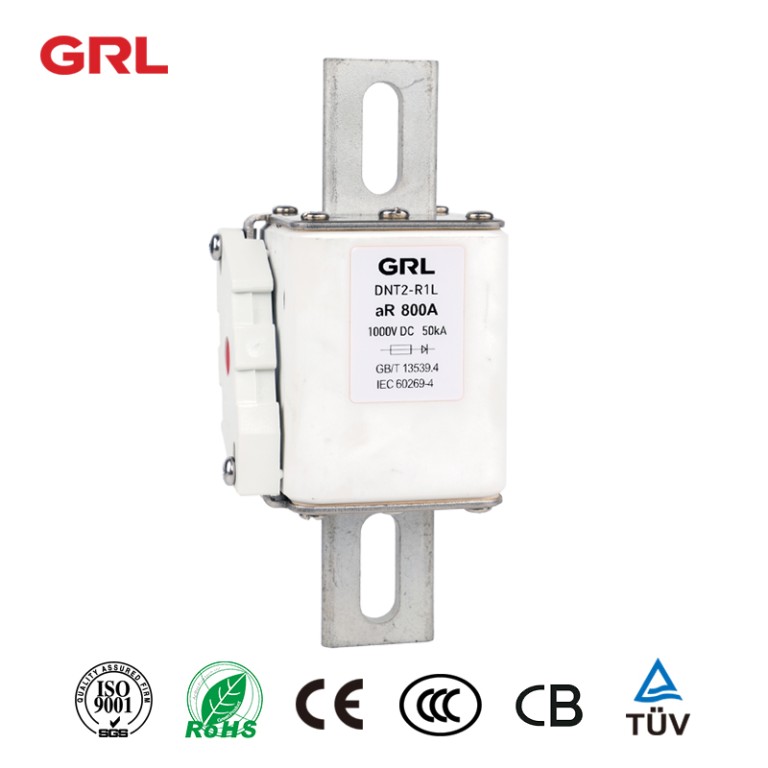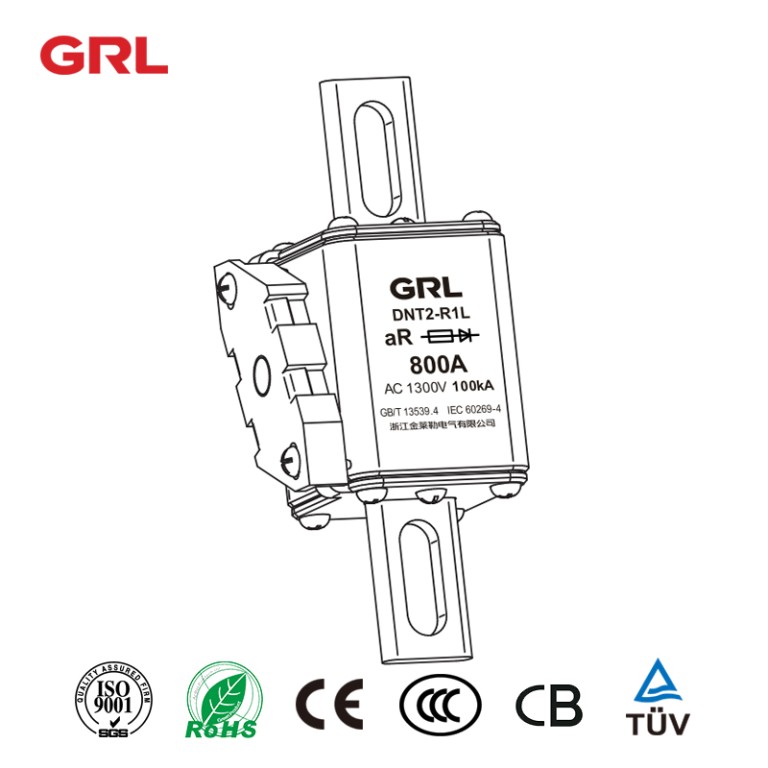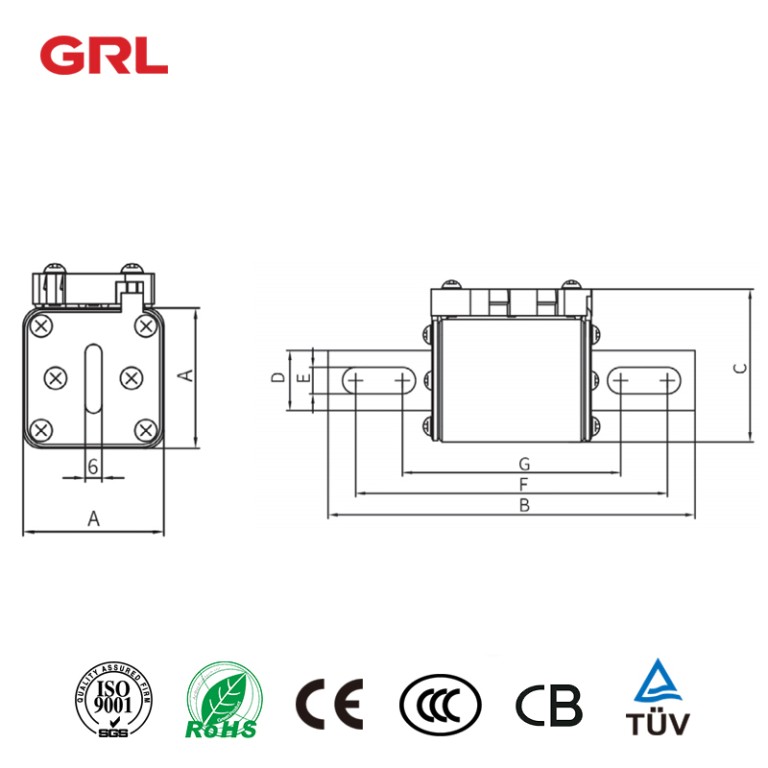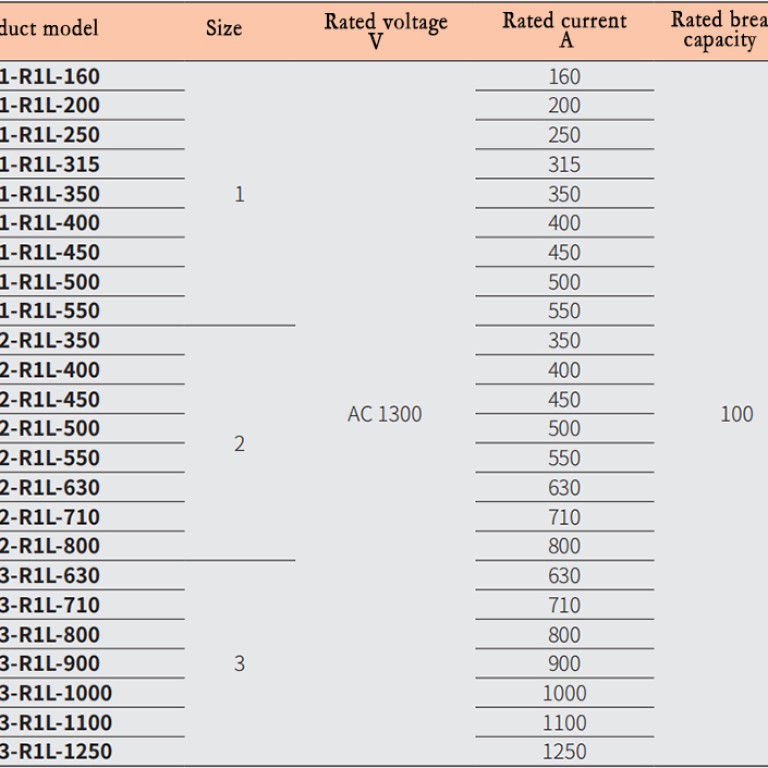Product description
The DNT □ – R1L series semiconductor equipment protection fuse is suitable for AC systems, with a rated voltage of 1300V and a rated current of 160A~1250A. It is used for short-circuit protection of semiconductor components and their complete equipment.
All performance indicators of the product comply with GB/T
13539.4/IEC 60269-4.
Basic parameters of fuse links
| Product model | size | Rated voltage V | Rated current A | Rated breaking capacity kA |
| DNT1-R1L-160 | 1 | AC 1300 | 160 | 100 |
| DNT1-R1L-200 | 200 | |||
| DNT1-R1L-250 | 250 | |||
| DNT1-R1L-315 | 315 | |||
| DNT1-R1L-350 | 350 | |||
| DNT1-R1L-400 | 400 | |||
| DNT1-R1L-450 | 450 | |||
| DNT1-R1L-500 | 500 | |||
| DNT1-R1L-550 | 550 | |||
| DNT2-R1L-350 | 2 | 350 | ||
| DNT2-R1L-400 | 400 | |||
| DNT2-R1L-450 | 450 | |||
| DNT2-R1L-500 | 500 | |||
| DNT2-R1L-550 | 550 | |||
| DNT2-R1L-630 | 630 | |||
| DNT2-R1L-710 | 710 | |||
| DNT2-R1L-800 | 800 | |||
| DNT3-R1L-630 | 3 | 630 | ||
| DNT3-R1L-710 | 710 | |||
| DNT3-R1L-800 | 800 | |||
| DNT3-R1L-900 | 900 | |||
| DNT3-R1L-1000 | 1000 | |||
| DNT3-R1L-1100 | 1100 | |||
| DNT3-R1L-1250 | 1250 |
Appearance and installation dimensions

What is aR fuse link?
aR fuse link also known as Semiconductor protection fuses, fast fuses
Semiconductor protection fuses, often referred to as fast fuses or high-speed fuses, are specialized electrical components designed to protect semiconductor devices like diodes, transistors, and other sensitive electronic components from overcurrent conditions. These fuses are characterized by their ability to quickly interrupt the current flow when a fault or overcurrent event occurs.
Fast fuses are used in applications where rapid protection against short-circuit or overcurrent conditions is critical to prevent damage to sensitive semiconductor devices. These fuses have specific characteristics such as fast response times and precise current ratings to ensure they provide effective protection.
It’s important to select the appropriate fast fuse for a given application, as using the wrong type or rating could result in either insufficient protection or unnecessary tripping of the fuse.
1.Operating Principle: Semiconductor protection fuses operate based on the principle of thermal and magnetic protection. When the current exceeds the rated value of the fuse, it causes the fuse element to heat up, which eventually melts and opens the circuit.
2.Types of Semiconductor Protection Fuses:
Fast-Acting Fuses: These fuses have a very quick response time and are designed to protect sensitive semiconductor devices from short-duration, high-current events.
Ultra-Fast Fuses: These fuses have an even quicker response time than fast-acting fuses and are used in extremely sensitive applications.
3.Current Ratings: Semiconductor protection fuses are rated based on their current-carrying capacity. It’s crucial to select a fuse with a current rating that matches or slightly exceeds the nominal operating current of the protected semiconductor device.aR fuse link
4.Voltage Ratings: The voltage rating of the fuse should be equal to or greater than the voltage of the circuit it is protecting. Using a fuse with a lower voltage rating can lead to unreliable protection.
5.Application Considerations:
Circuit Design: Proper circuit design, including the placement of fuses and other protective components, is crucial to ensure effective protection.
Coordination with Other Protection Devices: Fuses are often used in conjunction with other protective devices like circuit breakers to provide comprehensive protection.
6.Standards and Compliance: Semiconductor protection fuses are subject to industry standards and certifications. Ensuring that the chosen fuse complies with relevant standards is essential for safety and performance.
7.Fuse Sizing and Selection: Proper selection involves considering factors such as the type of semiconductor device, expected fault currents, ambient temperature, and other environmental conditions.
8.Failure Modes and Reliability: Understanding the potential failure modes of fuses and their reliability characteristics is important for ensuring long-term protection.
9.Testing and Maintenance: Regular testing and maintenance of fuses are essential to ensure they are functioning as intended.
Click to view grl group company information>>
Click to view grl fuse link product>>
Click to view fuse base product>>
Click to view fuse holder product>>
leave your question
Get your Comfortable Solution
![]()
GRL Electric Co., Ltd. is one of the leading companies in the Middle And High End market of low-voltage electric in China








